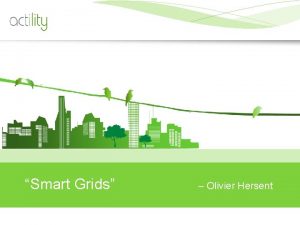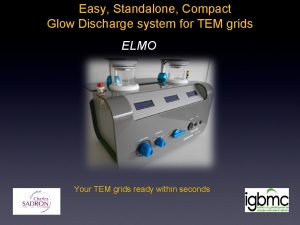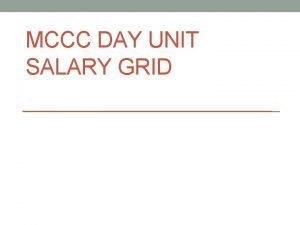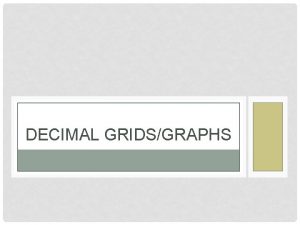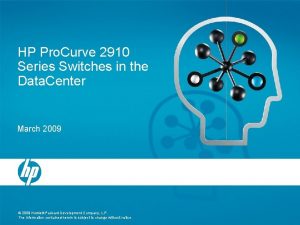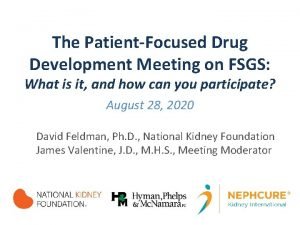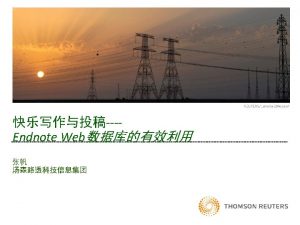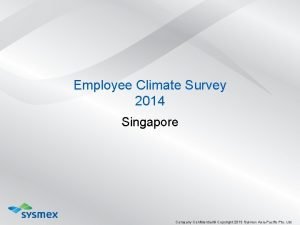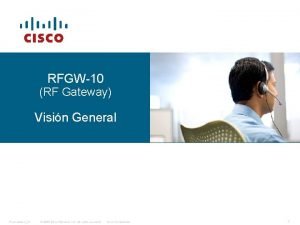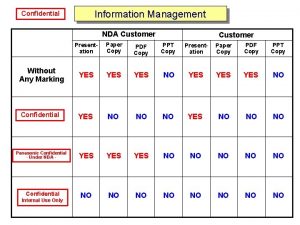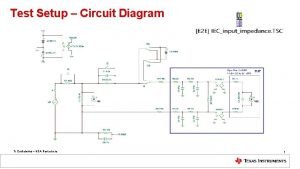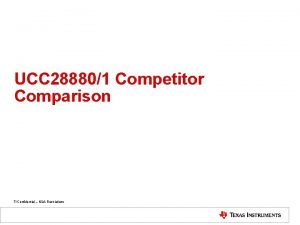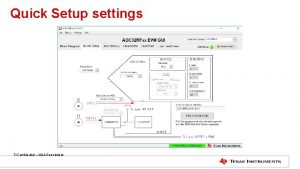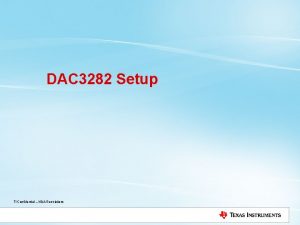Smart Grids 1 1 Actility Confidential Under NDA


















































- Slides: 50

“Smart Grids” 1 1 © Actility – Confidential – Under NDA – Olivier Hersent

AGENDA Introduction Smart Grid key issues Load shifting and demand response Admission control 2 © Actility – Confidential – Under NDA

Market Dynamics Smart Objects Things get connected (GPSs, Cars, Appliances…) Utility Deregulation Innovation requires active presence at the customer premises (smart-metering, demand management) Mass scale M 2 M Internet of Things Active object management From 100000 to 100 M devices Electric Vehicles Requires active distribution network management 3 © Actility – Confidential – Under NDA Renewable Energies Requires active production management

ETSI M 2 M standard User premises ETSI M 2 M m. Ia Network core Bootstrap Monitoring Config. Mngt. TR 069 configuration servers Thing. Park Portal (ETSI M 2 M configuration middleware) Registration NA/GA messages ETSI M 2 M NSC Multiple protocols (Zig. Bee, w. MBus, KNX, …) 4 © Actility – Confidential – Under NDA (Registration, NAT traversal, Routing, security) ETSI M 2 M Network Applications

AGENDA Introduction Smart Grid key issues Load shifting and demand response Admission control 5 © Actility – Confidential – Under NDA

Le fonctionnement classique des électriciens Demand is random but can be predicted Production can be planned 6 6 © Actility – Confidential – Under NDA

Electricity markets MWh Forecast consumption for 15/11/2014 (Profiling) Last spot purchases 11 AM Purchase of peak power blocs Purchase of base power t 7 7 © Actility – Confidential – Under NDA

The grid balancing issue In general actual consumtion ≠ forecast and 8 8 © Actility – Confidential – Under NDA P≠C

Management of balancing reserves 9 9 © Actility – Confidential – Under NDA

Fast reserve Example of France 12 GW of installed power Hydro, Fuel, Natural Gas 10, 2% of capacity around Paris Over 4 GW to build 10 10 © Actility – Confidential – Under NDA

The world changes Random production from renewables 11 © Actility – Confidential – Under NDA Intelligent consumption

Integrating renewables – Europe’s biggest energy challenge § The integration of renewables is the biggest challenge currently facing European network operators. For some, the effort is considerable. Others can simply rely on “legacy” renewables (most of which are hydro resources). The share of renewable energy in the national energy mixes and the targets for 2020. Source: CODA Strategies Demand Response opportunities on the European markets. CODA Strategies. February 2013. 12

Wind capacity in Europe § The introduction of wind power into the European grids is one of the major factors improving the Demand Response business case. Wind power capacity penetration levels (% nominal) among different balancing authorities • 7 European balancing authorities among the 12 leaders in integrating wind power into their energy mixes (more than 10%) • 5 balancing authorities deal with 30% or more wind power in their energy mixes, with Eirgrid at 28, 8% coming in in 6 th place • Germany and Denmark are the leading countries: 50 Hertz (East Germany) and Energinet DK are the leaders • All countries with significant wind capacity penetration levels already have some form of balancing mechanism, in which demand can at least bid into • American TSOs buy fast demand response as ancillary services (fast reserves and regulation – both upward and downward). Some German TSOs are also buying ancillary services from demand sources in bilateral contracts, yet the practice is generally limited in Europe (REE and Terna also have some facilities) Source: CODA Strategies, based on DOE-Alstom data Demand Response opportunities on the European markets. CODA Strategies. February 2013. 13

Integrating renewables – Europe’s biggest energy challenge § Most European grid operators will face the challenge of introducing more renewable generation onto their networks. While some will orient themselves towards traditional – controllable renewable generation (hydro in most cases), others will be forced to develop important wind capacities. Germany, the United Kingdom, Ireland, Denmark and to a certain extent Spain will be exposing an important part of their energy networks to the instability associated with the use of onshore and offshore wind. § It is this instability that will change the way electricity grids are managed: today, the issue is keeping costs low and shaving the peak, as grid security is not yet massively affected by intermittent generation. As we near 2020, the focus will have to evolve towards “keeping the lights on” in instances of forecast errors, over or under generation. § As more renewables also enter the energy markets (with a mandatory purchase obligation), SPOT prices are starting to see important fluctuations and the spreads between peak prices and trough prices are increasing. Demand Response opportunities on the European markets. CODA Strategies. February 2013. Breakdown of renewables targets by type of generation. Source: Poyri In order to reach their European targets, some countries will be relying more on controllable renewable generation, such as hydro, while others will be forced to rely mostly on intermittent generation, such as onshore and offshore wind. The risks associated to the use of intermittent generation, will most likely be the main drivers of Demand Response and other “balancing” technologies in Europe (such as grid-storage). Renewable integration is already considered as the central challenge by most European grid operators. 14

Integration of renewables and the effects of intermittency § § Traditionally, the major issue has been managing the peak. Wind however, is mandating grid operators to switch to a “real-time operations” framework, where grids have to be constantly balanced upward and downward. More intermittent generation means even more challenges to regulation, as wind in particular can provoke massive increases or decreases of net load on a grid (several hundreds/thousands of MW can come up / go down in a matter of minutes). As this study will show, the invariability of certain types of renewable generation has a massive impact on both the way grid operations are conducted and on the end prices as they reach the markets. Output curves of 30 days of production at the Tehachapi wind farm, June 2006 Summer day in California (wind and PV in energy mix) and what balancing the grid entails Source: PG&E The 30 days of production at the Tehachapi wind farm clearly show the challenges associated to managing significant amounts of wind generation unto a grid. Wind has two major effects on grid operations: it impacts ancillary services as reserve requirements need to be stepped up and it impacts electricity prices producing both negative values (when there is an excess of production) and very high positive values (when wind forecasts show production deficiencies). Similar issues are raised with PV, as the Californian example clearly shows. Source: PG&E Demand Response opportunities on the European markets. CODA Strategies. February 2013. 15

Integration of renewables and the effects of intermittency § § Denmark is a good example of the effects of intermittent generation on grid balancing operations and particularly on energy prices. A country that is already relying on wind output for more than 25% of its energy mix, Denmark is part of the Nord. Pool, thus interconnected to the other Scandinavian countries (Norway, Finland). It is also connected to Germany. Belonging to Nord. Pool guarantees a fairly liquid market and no tranmission costs or constraints between members. This means Denmark can quickly and cost free export excess production. Despite this level of liquidity and interconnection, the Danish system is incapable of exporting sufficient energy in times of high production and low demand. This is why, since 2009, to better balance the grids, the transmission system operator has allowed prices to become negative in situations of over productions. As prices can now sink as low as 119, 90 € per MWh, generators are incentivized to produce less and consumers to acquire more energy, thus practically providing downward regulation. Danish interconnections and output on a typical September day (1: 00 PM) Evolution of electricity prices on the Nord. Pool SPOT market, during three winter holiday days § Source: CODA Strategies, based on Nord. Pool data Demand Response opportunities on the European markets. CODA Strategies. February 2013. 16 The liquidity of the market is not sufficient as to ensure that the grid is always balanced. Situations where prices are steadily negative for several hours are not uncommon. This is why either consumer participation or storage technologies are necessary in Denmark.

“The day the wind died” § The contribution dynamic demand response can make to grid security has already tried and tested in the Texas grid, administered by ERCOT. The ERCOT grid occupies the entire Texas interconnection and remains to this day essentially unconnected to electrical grids in other states. This practically means that in the absence of interstate electricity commerce, the ERCOT area does not fall under federal regulation. This has its benefits in terms of regulatory independence, but also its disadvantages: Texas cannot use interconnections for grid balancing. This can be challenging in a state that is the number 1 user of wind power on the North American continent. § As this example will show, in order to ensure the security of the grid, ERCOT uses Demand Response, to an impressive extent, particularly in ancillary services. These services are constructed in order to stimulate demand participation, rather than hamper it. § On Feb 26, 2008, the ERCOT grid was confronted with what has come to be known as “The Day the Wind Died”. The main trigger of the event was forecasting error. As the graphs to the right show, resource planning did not anticipate a capacity deficiency. Plans reflected considerably more generation than was actually available. § The day-ahead forecast was inaccurate (at certain points of the day, by more than 1000 MW). The situation did not improve with the hourahead forecast which was similarly inaccurate. The day-ahead wind forecast (notice the forecast error) The hour-ahead wind forecast (forecast error increases) Source: ERCOT Demand Response opportunities on the European markets. CODA Strategies. February 2013. 17

Ripple effect on merit order : decommissioning of peak power plants Demand Response opportunities on the European markets. CODA Strategies. February 2013. 18

Thermal power not the adequate response § It is clear that thermal generation is set to remain the major source of balancing capacity in the short and medium term. The need to manage significant quantities of intermittent production will constrain power plants to function outside their normal operating patterns, which in turn will certainly lead to higher maintenance costs and in certain cases decrease the life span of these installations. Stress corrosion cracking In order to be used for managing the operating challenges associated to significant quantities of intermittent generation within the energy mixes, power plants will have to see their use parameters modified for: • Increased unit ramping • Increased ramping speed • Increased unit cycling (start/stops) • Need for reduced minimum loads Corrosion Fatigue The issue is that not all units are designed for this mode of operation. Using units in such a manner usually results in high maintenance costs or even plant breakdown in some situations. Fatigue Creep Demand Response opportunities on the European markets. CODA Strategies. February 2013. 19

Less peak energy, more peak power : in some countries utilization of peak power decreases § The evolution of energy mixes will also require the management of renewable specific over-/under-generation issues. Night time wind farm output and day time solar will prove challenging to manage in grids with low flexibility or over-dependence on interconnections (that saturate in time). As storage is far from economically viable in most situations, grid security will be dependent on the ability of demand resources to react to grid conditions. Markets will have to stimulate participation throughout the day, rather than only during peak times. The main barriers of DR participation onto these markets (such as excessive capacity requirements and the relationship between the DR aggregator and retailer of the resource being curtailed) will have to be dropped. In deed, some markets have already removed these barriers and as a result are seeing strong participation in their services. Managing the Californian grid will require a dynamic approach to flexibility – one that a capacity market alone will not be able to provide Similar to Germany, California is set to see massive challenges to its grid management due to changes in its energy mix. As the graph to the right shows, as more PV enters the grid, starting 2015, net load sees massive decreases during the day and a stronger need to ramp up during the evenings. In California, in particular, this is seen as a strong incentive for Demand Response, be it tariff based, in energy or in ancillary services. Although the issue of managing the peak will still be present due to the consumption patterns of American households and the massive use of air-conditioning, over-generation during the day will incentivize loadshifting and active consumption management. This will lead to participation in dynamic DR markets (energy, ancillary services, or just tariff-based DR) rather than capacity markets (which, although easier to set up initially for peak management, will not have a lot of value when faced with situations of overgeneration). Demand Response opportunities on the European markets. CODA Strategies. February 2013. Source: CAISO 20

Thermal power capacity decreases ! Net Change in GB transmission connected capacity to 2020 § The introduction of wind alone isn’t the sole major evolution of European electricity grids. In most countries, this is accompanied by a reduction in flexible thermal generation, usually coal and oil. While gas will continue to see increases in its use (particularly at current prices), most of the flexible capacity will be replaced by intermittent generation (mostly from wind). § Countries that still rely heavily on coal generation, and that will be compelled to replace are Germany (which will most likely have to continue using coal resources for a longer period of time than previously expected), Denmark (still coal reliant but already seeing vast amounts of wind in the energy mix), the Netherlands (traditionally coal reliant, moving to gas, CCS, etc. ) and the UK which has already passed a directive (Large Combustion Plant Directive) to “clean-up” (via CCS) or shut down large combustion plants that are heavy polluters. Demand Response opportunities on the European markets. CODA Strategies. February 2013. Source: national grid The United Kingdom is just one example of how national energy mixes will be evolving. While net capacity in itself will be increasing, the volatility of generation will also be going up as more wind enters the energy mix and considerable amounts of traditional thermal generation are taken out of use (coal and oil are the first to go, although gas use is expanding throughout most European countries). Denmark, the Netherlands, Germany are just a few important European players that join the UK in having to balance their grids with considerably less flexible generation and considerably more intermittent capacity. 21

e r o ild m u b o t d e e n ? e ? w ? o s t d , n a o l S p r e w o p k pea 22 22 © Actility – Confidential – Under NDA

Grid management options § Intermittent generation can be managed in several ways. Using traditional generation to back-up wind output only provides upward regulation, which is insufficient for important wind capacities. A handful of solutions may provide sufficient intermittency relief: a highly liquid market would provide sufficient upward and downward capacities rapidly, as would a thoroughly interconnected system (with high capacity interconnections). Storage is also an option, but the business model is not yet clear as technology cost is still a major weakness. By most accounts, the only viable option would be Demand Reponse. High market liquidity Markets that are sufficiently liquid to mobilize generation/consumption rapidly, from a high number of participants. Electricity prices vary rapidly and reflect the state of the system (there is no capacity market). System instability is rapidly translated into “€/k. Wh”. Demand Response Providing sufficient incentives for endcustomers to provide both reductions and increases in capacity, rapidly. Simply providing slow capacity is only useful for peak shaving, but not for rapid balancing of wind over / under-production. Demand Response opportunities on the European markets. CODA Strategies. February 2013. Good interconnection capacity Managing intermittent generation = providing both upward AND downward “regulation” 23 A high number of interconnections that allow for important upward / downward capacities to be rapidly available. Storage technologies have the technical capabilities to provide fast regulation (power applications like fly-wheel storage, certain batteries, some forms of rapid thermal storage), but the technologies are not yet mature and the costs are particularly high for the moment.

Energy management is evolving towards a faster, more active approach • Improvement in process and equipment efficiency • Intelligent appliances, building management systems, etc. Demand Response opportunities on the European markets. CODA Strategies. February 2013. • TOU and CPP pricing • Capacity markets • Slow DR, upward only (1 hour and more) 24 • Real time pricing (market correlated) • Liquid energy markets • Fast DR for ancillary services (upward and downward) 24: 00 12: 00 00: 00 § While energy efficiency has been an active concern of European grid operators for a number of years, the new constraints associated to 2020 -20 -like commitments has broadened the discussion active energy management. The issue of peak management has also been at the forefront of transmission system’s operators constraints for a number of years, either through dynamic tariffs (time-of-use tariffs introduced in France in the 70 s) or through direct load control. Peak management has also driven the creation of a series of DR markets, historically fed by interruptible tariffs. The reality of today’s energy grids is pushing the discussion towards the development of ever more active energy management procedures. As capacity prices forming in competitive market places are dropping, value is shifting from peak management to real time demand management and consumption optimization. New tarifs are appearing, markets are becoming more liquid and with the introduction of intermittent renewables, transmission system operators’ needs for ancillary services are expanding massively. DR is one of several measures allowing to protect from intermittency in today’s grids. Up- and downward regulation (filling Peak reduction Energy efficiency valleys and flattening peaks) 24: 00 §

Demand Response is evolving § Traditionally, Demand Response has been seen considered at best as a slow “answer” to grid balancing challenges. By far, the structures that currently see the most demand participation are capacity-type structures. This is because, on the one-hand, such structures are easy to implement, and on the other hand, they usually incentivize consumers with significant financial returns. There are multiple ways in which Demand Response can participate in balancing the grid Capacity-only • Consumers get paid to be available to reduce load. The availability is paid, on top of the actual reduction. Usually a 1 h or 2 h market. • Easy to implement • Low Barriers to entry • Primary CSP Offering wherever the market is present • Usually the “cash-cow” of Demand Response opportunities on the European markets. CODA Strategies. February 2013. Day-ahead Energy Real time DR – dynamic pricing • Consumers bid into a day-ahead market, pledging their load reductions. Voluntary scheme, only reduction is paid. • Measure and monitoring • Daily Price Settlement • LSE market • Usually low revenue market, as it provides a low benefit for the grid operator • Consumers provide capacity but also consume more if the grid requires it, in near real time or fast (10 minutes). • Practically real time market • Low use currently • Technology barriers to entry • Very high value for grid operators, so potentially high revenue market for customers 25

Peak (Capacity) is less an issue, intermittency is THE problem § § Using old models for balacing the European grids will no longer be an option on a mid-term basis, mainly because the traditional issues of peak management will be evolving. This is already visible in some European grids, of which Germany is by far the best example. The traditional early morning-noon peak is disappearing as more PV gets into the grid. The evening peak is also flattening out due to solar overcapacity (although there is considerably less output then at noon, on a good day PV will still produce 6 GW of capacity). Apart from grid management, the German grid transition is having an important effect on electricity prices. As managing a grid from a capacity point of view is becoming less and less important, ensuring security when faced with intermittency is becoming the central task of European grid operators. Renewable grids are not faced with the same issues as traditional grids The effects of massive solar output on the 25 th of May Solar output is having a massive impact on the net load curve on the German Grid. The noon peak in particular is reduced, but there is a strong effect on the evening one as well. Source: EEX Demand Response opportunities on the European markets. CODA Strategies. February 2013. 26

The upcoming paradigm Demand is random but can be predicted Production can be planned 27 27 © Actility – Confidential – Under NDA

Demand Response today Statistical analysis - Large uncertainties No hard proof of D/R volume Underestimated energy volumes Underestimated costs Complex systems out of scope Phone calls 28 © Actility – Confidential – Under NDA Bids

Automated Demand Response Bids Monitor state Simulate 29 © Actility – Confidential – Under NDA Exact energy estimates Exact cost estimates Always-on bidding Proof of D/R energy volumes Quantitative Back Testing

Automated Load shifting & demand response The solutions cover load shifting (LS) and demand response (DR). Both solutions perform a bottom-up quantitative analysis based on a physical model of the process under control 30 © Actility – Confidential – Under NDA

Statistical analysis Real time parameter data - - volume, temperature, consumption, availability… Aggregation engine Physical models - Constrained optimization Purchasing/Selling optimization - Industrial process simulation model Computes: - Production/consumption nominal schedule - Maximum adjustment volume, upward and downward - Minimal adjustment offer prices - Summation of offers Safety margins Financial models, optimal adjustment bid offers. OTC interface Internal market prior to TSO bidding TSO/tech interface - De-aggregation engine - Split activations to individual commands - Consolidation of payments Penalties Reporting - - © Actility – Confidential – Under NDA Bid submission and management Periodic bid updates. TSO/finance interface - Real-time control Database of adjustment prices/volumes Forecast models Dashboard : predicted vs actual schedule, gains and penalties per activated bid. Post-mortem analysis of won and lost bids. Adjustment potential estimations. Optimization of nominal schedule

From process to model 32 © Actility – Confidential – Under NDA

Back-testing 33 © Actility – Confidential – Under NDA

Immediate activation request on participant dashboard Automatic handling of failures & intra-aggregate reserve power 34 © Actility – Confidential – Under NDA

Monitor execution & compliance TSO / Agregator dashboard 35 © Actility – Confidential – Under NDA

AGENDA Introduction Team, experience and market positioning Roadmap Architecture, ETSI M 2 M backgrounder Smart Grid applications Smart-LS® , Smart-DR® Example practical case Screenshots Smart-EV, Smart AC 36 © Actility – Confidential – Under NDA

AC® - Activating the distribution network Real-time monitoring and admission control of electricity distribution networks becomes unavoidable 37 Increased renewable production power : correlated production peaks Increased EV penetration : correlated demand peaks © Actility – Confidential – Under NDA

Typical benefits From a DSO estimate : 100 hrs of wind turbine power cut / year Connectable renewable power * 3 38 © Actility – Confidential – Under NDA

Large scale admission control Initialized with profiled constraints and loads Updated with real-time measurements and admission state 39 © Actility – Confidential – Under NDA

Decomposing the problem An admission request ADM is a discrete time power schedule P Q 40 T T © Actility – Confidential – Under NDA 2 1 T 3 T 4 T 5

Decompose in space domain Adm. Req. Leaf #1 Adm. Req. Leaf #2 Adm. Req. Leaf #9 Adm. Req. Leaf #10 ACS router #1 41 #2 #3 #4 © Actility – Confidential – Under NDA #5 #6 #7 #8 #9 #10 #11

Decompose in time domain Adm. for leaf #1 Radial networ k. R T 1 42 © Actility – Confidential – Under NDA T 2 T 3 T 4

View for one network and one time period For each admitted flow Adm #1 c i m a Dyn a Class 1 at d For each +15 A element of the distribution network Stati c data 43 © Actility – Confidential – Under NDA Adm #2 Adm #3 Class 1 Class 2 +20 A -10 A Max rating Warning 50 A 45 A Priority level For each constrained physical grandeur on the element

Three-Phase networks Balanced networks : one connexion abstracts 3 identical phases offset by 120°. 44 In the US, networks are very unbalanced In the industry, we may have phase to phase loads… In HV NWs : balanced © Actility – Confidential – Under NDA Fortescue Xform (computationaly easy) : - Direct (only component if balanced) - Indirect - Homopolar

Distribution grid real-time model (1) 45 © Actility – Confidential – Under NDA

Distribution grid real-time model (2) 46 © Actility – Confidential – Under NDA

Ongoing projects Projet : 47 © Actility – Confidential – Under NDA Projet :

48 © Actility – Confidential – Under NDA

OFFICE • Reduce common space lighting • Change temperature setpoints MANUFACTURING • Reschedule lines and processes • Curtail compressor lines • Conduct equipment maintenance 49 WATER TREATMENT PLANT • Reschedule pump activation REFRIGERATED WAREHOUSE • Adjust HVAC setpoints • Leverage cold water storage capacity © Actility – Confidential – Under NDA GRINDER, MILL PLANT • Anticipate or delay grinding schedule • Conduct equipment maintenance

Merci pour votre attention ! info@actility. com 50 50 © Actility – Confidential – Under NDA
 Demand response in smart grids
Demand response in smart grids Glow discharge tem
Glow discharge tem Acted salary grid
Acted salary grid Layered architecture for web services and grids
Layered architecture for web services and grids Bootstrap 4 grids
Bootstrap 4 grids Decimal using grids
Decimal using grids Differentiation grids
Differentiation grids Off focus grid error
Off focus grid error Parallel research kernels
Parallel research kernels Nda-2910
Nda-2910 Dratsch
Dratsch Difference between nda and anda slideshare
Difference between nda and anda slideshare So nda
So nda Cisco titration
Cisco titration High density low density
High density low density Nda
Nda Kevlar
Kevlar Nda
Nda Dell nda
Dell nda Dac dee fly
Dac dee fly Nda phru,
Nda phru, Nda
Nda Nda
Nda Dell nda
Dell nda One smart man he felt smart
One smart man he felt smart Street smart vs book smart quotes
Street smart vs book smart quotes It's not how smart you are it's how you are smart meaning
It's not how smart you are it's how you are smart meaning Future smart smart shopping answers
Future smart smart shopping answers Street smart vs book smart quotes
Street smart vs book smart quotes Book smarts vs street smarts
Book smarts vs street smarts It's not how smart you are
It's not how smart you are One smart man he felt smart
One smart man he felt smart Distribute images
Distribute images Suranne jones strictly confidential
Suranne jones strictly confidential Confidential for internal use only
Confidential for internal use only Confidential for internal use only
Confidential for internal use only Confidential logistics company
Confidential logistics company Intel confidential
Intel confidential Confidential not for distribution
Confidential not for distribution Blancco oy
Blancco oy Hp confidential
Hp confidential Airbus deutschland gmbh
Airbus deutschland gmbh Confidential do not circulate
Confidential do not circulate Types of ferrites
Types of ferrites Private and confidential
Private and confidential Smart document solutions
Smart document solutions Sql server roadmap
Sql server roadmap Tcs confidential
Tcs confidential Company confidential singapore
Company confidential singapore Slot rf confidential
Slot rf confidential Strictly private and confidential
Strictly private and confidential
